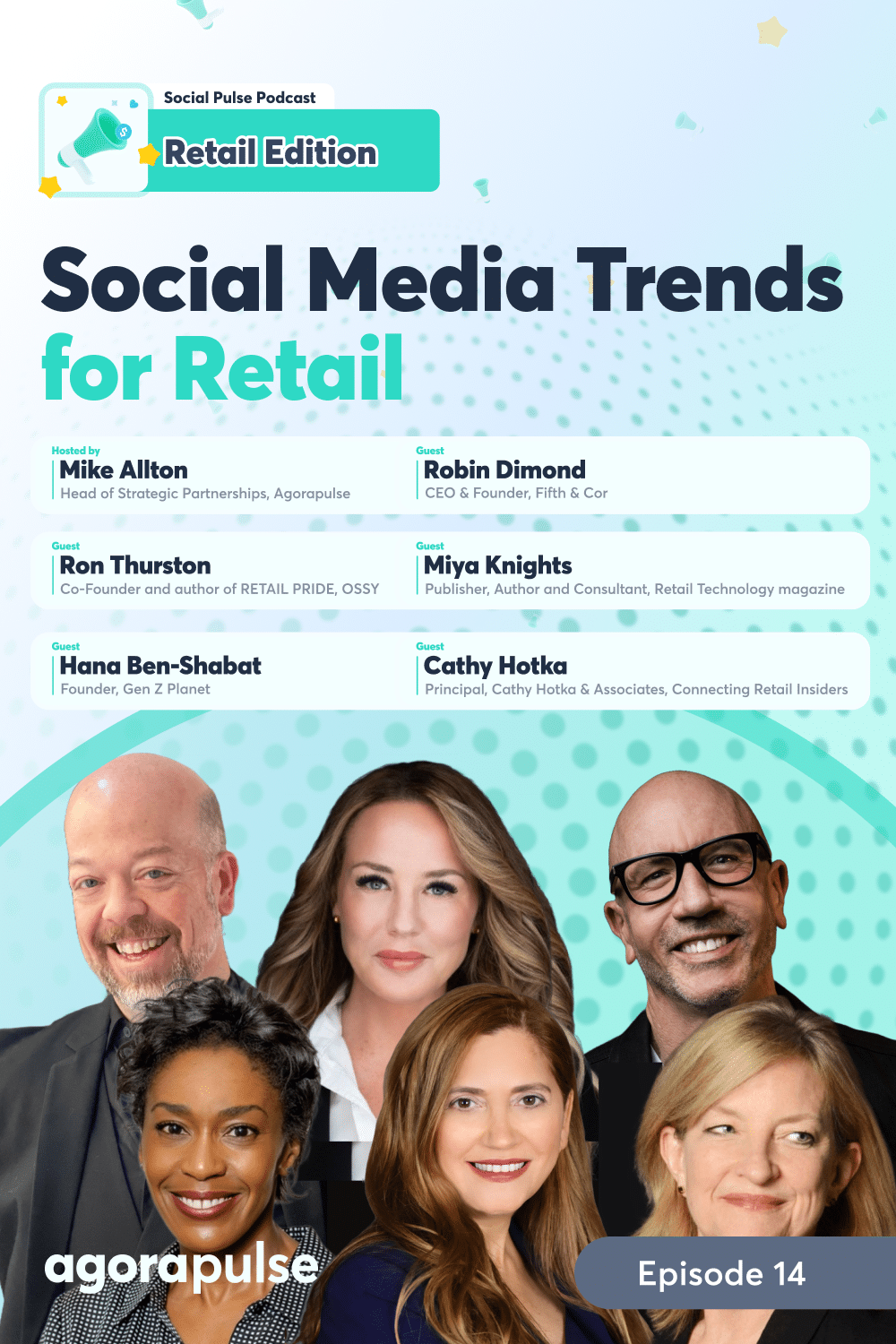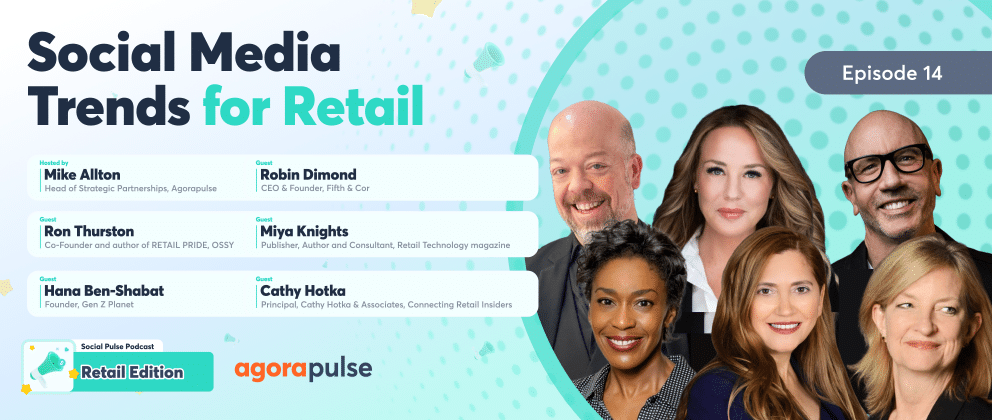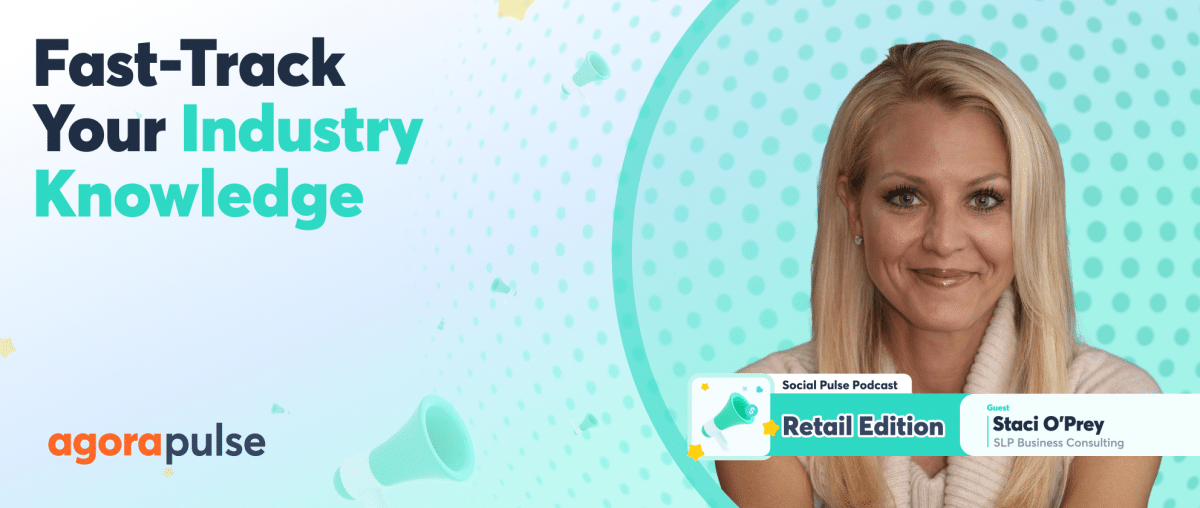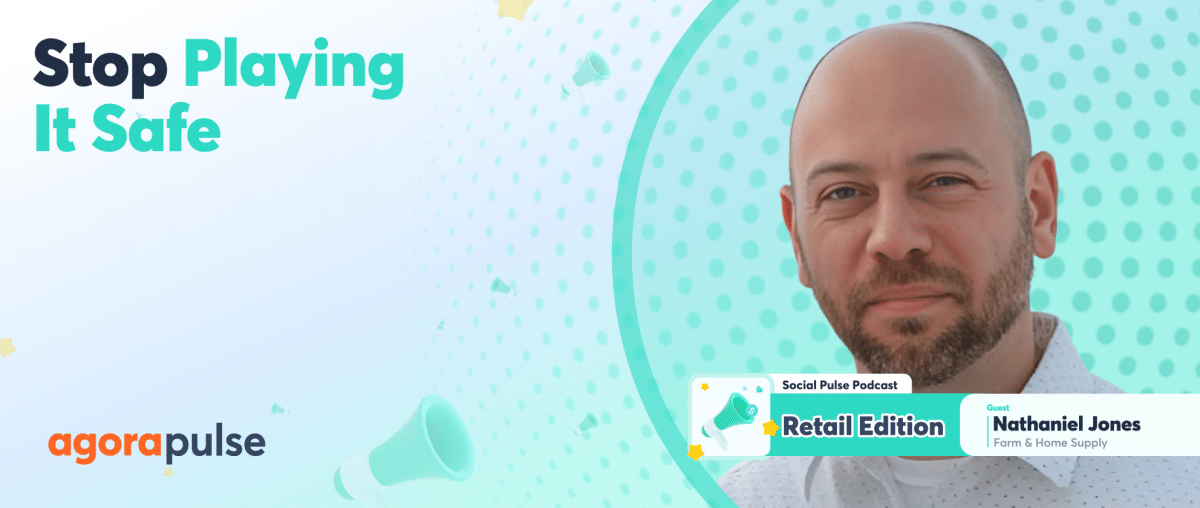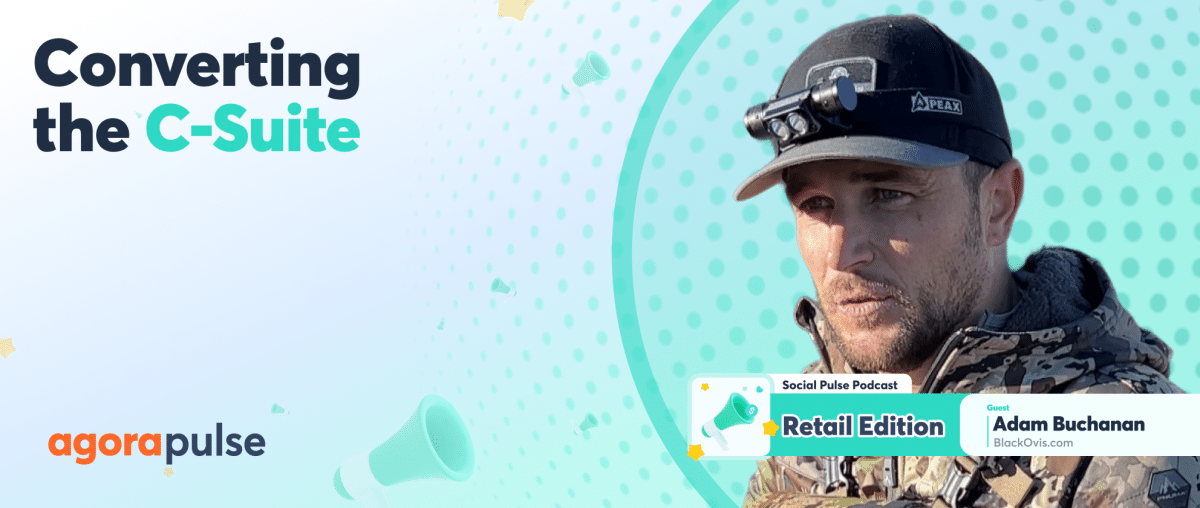In this recap of the Social Pulse Podcast: Retail Edition, a panel of marketing experts in the retail space share their insights on how to spot and act upon social media trends for retail. Read on for the transcript or listen to the podcast below.
Meet the Panelists
Mike Allton: I’m Mike Allton. I’m chief storyteller at Agorapulse. My book on Amazon is The Ultimate Guide to Social Media Marketing, which was a co-authored book. I’m joined by my amazing and remarkable co-host, Robin Dimond, as well as Hana Ben-Shabat, Cathy Hotka, and Ron Thurston. I’m going to give each of you a few seconds to introduce yourselves.
Starting with you, Robin, you just swooped in right on time. Who are you? What do you do?
Robin Dimond: Hi, everyone. I’m Robin Dimond. I’m the CEO and founder of Fifth & Cor. We are a marketing and innovation company, and I am super excited to have made it on time as I’m running.
Hana Ben-Shabat: Hana Ben-Shabat. I’m the founder of Gen Z Planet. We are a research and advisory firm focusing solely on Gen Z and helping brands to understand Gen Z, both as consumers and as employees.
Cathy Hotka: I’m Cathy Hotka, former VP of IT at the National Retail Federation. And what I do is help technology companies reach CIOs and CTOs.
Ron Thurston: Sure. Hi, everyone. I’m a long-time retail executive head of stores for brands you may know like Intermix, Saint Laurent, and Apple. I have a couple of different podcasts, Retail in America and Frontline Fridays, and the book Retail Pride, and recently launched a new retail recruiting platform called Ossy.
Exciting Developments in Retail Marketing
Mike Allton: I’m going to start with you when it comes to retail marketing and social media in particular, what’s got you excited already this year? It’s only March. What’s exciting?
Hana Ben-Shabat: For me, the most exciting things that happened this year—I think it’s obvious. It’s the arrival of ChatGPT and tools that are doing the same because one of the biggest struggles that I’ve seen over the past, I don’t know, 10 years is the whole content creation. And it is a beast that needs to be constantly fed.
“And there is a limit to how much one person or even a team can produce and get the results that they’re looking for. So, in many cases, it was like a hit-and-miss. And whatever people tried, it’s very hard to get the virality or the effects that you are looking for. And now we got these tools that I believe have the potential to transform not only the role of the content creators, but also the outcomes that they achieve in the marketplace.”
And I believe that that’s gonna be a big change, and it’s a very exciting change.
Cathy Hotka: I’d like to add to that. I think what Hana said is important. Consider also that the new 2D barcode, which is coming out of GS1, is going to allow retailers to have all kinds of content on the product itself.
All the customer has to do is scan it with a phone, and they can see all this content, which they, by the way, don’t have right now. So they’re going to be looking for new ways to create content. They’re going to be looking for companies that can assist them in doing this, and that can also help them with their social media outreach as well.
Mike Allton: I’m a retail noob and ignorant person other than being a consumer. So help me with this. So a 2d barcode is essentially a QR code that’s now acting also as the barcode, but it’s now linking to just a landing page that can have whatever they put on it?
Cathy Hotka: Right now, that barcode is good only to the manufacturer and to the retailer. It doesn’t mean anything to the consumer.
But with a 2D barcode, which contains considerably more information, you as a consumer are going to be able to scan that loaf of bread and find out all kinds of new things about it that the label itself doesn’t have. Think about a loaf of bread. [It] is a pretty simple thing to buy, but think about computers and cameras and all the rest of it. You’re going to have access to a lot more information than you had before. But these folks who make these products are going to have to put that information together.
Mike Allton: It’s very similar to what I was just talking to Jenna Galardi this afternoon at Feedonomics about how their tool helps retailers take those products and distribute them to all these channels optimized for each individual channel.
Like you, to your point, the right character count, the right size images, backgrounds are all set and that sort of thing.
UGC and the Death of the Celebrity/Influencer
Ron Thurston: I’m gonna take a left turn here on a different topic and say what I’m most excited about is user-generated content. And a lot of this is because of TikTok, but this diminished the importance of celebrities and influencers, [which is] interesting. And I think now every brand that attaches a celebrity face to it is perceived as being less relevant, less interesting. I can’t see Kendall or Kylie on another brand. I just can’t. And because it’s so forced, and you just know that there’s money behind it.
And so this idea of people creating their own, becoming their own brands, being their own people, creating products—all of it is so interesting, and it’s so much more authentic and more about who we are. So I love this shift in our business having spent most of my career in fashion. Like, I understand the importance of this and how it can influence buying, and I just love this shift.
Mike Allton: Yeah, it’s a reduction in the number of real endorsements, because that’s really what those are. They’re not influencers. They’re not influencing based on any kind of authentic position. Robin, anything you want to add to that?
Robin Dimond: I think it’s tying everything together.
Being able to sit there and say, “Hey, there’s a shift in augmented reality,” which is the 2D QR code, barcode, which has been great. (Not to be misleading, it is not a QR code; it is a barcode. I know we personally did one for a restaurant, and we’re able to scan over, and you scan a barcode and [it] popped out all the ingredients where everything came from farm-to-table, what wine pairing it should be.
And, Ron, that user-generated content that came in blew our minds within a few hours of launching this. It was: Everyone wanted to be famous. Everyone wanted to play. Everyone wanted to screen capture. And I think we’re seeing all the worlds combined. I don’t call it content creation anymore.
It’s curation.
It is being able to pull in your world together and curate everything. And so we’re not going to see content creators. We’re going to see curators that are going in and leveraging AI. They’re leveraging this and they’re bringing it. It’s way more authentic.
Gone are the days of the Kardashians. I’m so sorry if they ever hear this. Gone, gone are those days. We want real people. We want to know what real makeup looks like on ourselves. We want to know what we eat. And we don’t want someone to say that it was paid for. I want to say, “This is the best meal I ever had, and no one ever paid for it.” So I think it’s brands embracing unapologetic authenticity. And if they do that, they will store over the next few years.
Worries About the Social Media Future
Mike Allton: I’m going to throw the next question at you to kick us off.
What are you worried or concerned about?
(And that can be from any perspective.)
Ron Thurston: I spent a lot of time speaking to brands, mostly on the people/retail side, but there’s so much conversation that I know is very concerning.
We talked about omnichannel earlier, but brands that are heavily e-commerce are most concerned about cookieless shopping, like, “What to do without cookies on my website? And I’m converting at on average 2% of this traffic. Who are these 98% of people who are on my site?”
And so there’s a future where you won’t know. “And how much of that business translates into my brick-and-mortar stores, how much of that translates into my wholesale business? How much of that translates into e-commerce?”
So I think that this and social media is the idea of customer transparency, customer knowledge of “Who is my customer, where are they going?”
You know, again, if I’m omni (and much of my business is wholesale), I don’t know who that customer is. If much of my business is stores, I can understand it for those who are converting if much of my business is only on my site. And I can’t track who is this?
The only way that we can create retention with customers is to know who you are and therefore give you content, give you ads, and keep you as a customer.
But if I don’t know who you are, that’s hard to do. So this retention, acquisition, conversion rates on websites, conversion rates in stores—all of these are just KPIs that we, I think, as an industry, are concerned about and how we’re going to continue to grow our business in an omnichannel way.
Mike Allton: Does anybody else want to add to what Ron just said or have any other concerns that they want to bring up?
Hana Ben-Shabat: One thing I’m worried about is the rise of what I call the Algorithmic Player. Which are Shein and Temu and even TikTok Shop recently.
Now, just to be clear, I’m all for competition because, at the end of the day, competition is what raises the bar for everyone else and also benefits the consumer. But when you see the methods and the sophistication that these retailers are using and the speed by which they capture market share in the United States, I am not sure that we have many retailers, definitely not in the mid-size, small-size retailers, who actually understand this method and can compete effectively. And I think that that puts so many companies in a really what I call the danger zone. And that worries me.
Mike Allton: Yeah, I made one purchase from Temu. And I was just blown away by, to your point, all the sophisticated methods and tactics that they were employing in this five-minute session to get me to spend more and more money and stay on the app.
Cathy Hotka: That’s what I was going to mention. I applaud Hana for saying that.
I was around when technology just began to take off in retail. And it was painful to watch because the larger players were able to just jump in, speak personally, with the CEOs of technology companies, and make that happen for themselves. And look at the result now. The companies that were laggards are laggards. Many of them are out of business. And so you’ve got companies that are not doing social media. They’re not sure how, and they need to go.
Robin Dimond: I would like to add on to that because what Ron said was striking, but then Hana, what you said: I’m worried about the small business owners out there, who were going to see a great divide
Unfortunately, for businesses, because they either shift priority and jump on right now, and they’re going to have to jump all in, shift. I mean, there’s only so much finance that everyone has. There’s almost so much funding as a small business owner, as we are all small business owners. That’s something that we think about to medium size if they don’t shift their mentality right now, to be future-thinking. Hana is right.
They’re going to be gone because we’re watching these changing times. These other ones buy up or just swallow whole, like the whole small businesses. So it’s either got to be a shift in mentality, and they’ve got to jump on this bandwagon, and they got to see it, but they can’t—to Ron’s point—teeter back there.
There’s going to be information that is missing, but they’ve got to go on. Gone are the days of like, “Let me see exactly where this person came from. Was it this social post?” And you’re like, “Stop asking what our return on investment is on that post.” It’s all of the things together, working together, and you should be seeing an uptick across your business.
My biggest fear is about the small [or] medium-sized businesses because I don’t want them to get swallowed up.
Social’s Multi-Generational Effects
Mike Allton: Now, I’m going to ask this next question to you because we were talking a minute ago about the challenges that different sizes of businesses are having.
Now we want to talk about the challenges that we’re having when it comes to generations or cohorts of consumers.
How do you see today’s changes or developments impacting these different generations?
Hana Ben-Shabat: I think there is a tendency to think in retail that the digital natives—the millennials and Gen Z—they don’t like stores, they just like online, and it’s not true.
Understanding the behaviors of different generations is truly important. I think it’s true for millennials, Gen Z, every single study we do—it’s very clear. They like to go to stores.
- Challenges of this. I believe that that puts great challenges for retailers because, at the same time that they like to go to stores, they are the true digital natives. So, they grew up with social media. They grew up with phones in their hands, and they know what they get from those digital platforms.
- Algorithm experience. In a way, consciously or unconsciously, when they arrive at the store, they expect the same personalization that they get from Netflix, the excitement that they get from Instagram, the discovery of TikTok, and the Uber frictionless experience. And they want to come to the store and get the same.
- What to think about. Now that raises the bar to actually what you do in the store, and you have to think about how you serve those customers in a way that satisfies that digital life that they have. I think it’s quite difficult, on the other hand. If it’s much more fun to scroll through an Instagram feed, why would anyone come to your store?
- Keep an eye on Gen Z. Now, when we look at how the different generations interact, it’s very clear to us that whatever happened with Gen Z never stayed with Gen Z. So, as they adopt new tools and behaviors, they start trickling up into other generations. So TikTok started as a Gen Z playground, and now we have Grandma TikToks.
I think the way you think about it is what Cathy said in the beginning, “You have to watch out for that new generation that is coming up because they are the precursor for where everybody else is going to go.”
And the more you understand them now, the better you’re going to do and you’re going to build. You’re going to build the tools that are going to last for the next generation.
Boomers, Gen X: Watching What Generation Is on What Platform
Cathy Hotka: If you want to reach geezers, go to Facebook. All my friends are posting pictures of their grandchildren there. I mean, understand the platform. It’s valuable, it’s valuable, but understand the platform and know who you’re talking to.
Mike Allton: Robin, I saw you cringe.
Robin Dimond: I cringe, and I know I’m going to go against you, and I don’t want to because I love you. But… I’m laughing too because I told my dad, “Hey, I can’t wait till this is going to be on a podcast.”
Literally, the reason I’m running late is because my dad was helping me with my Instagram. My father, who’s 73, is, like, “You just swipe up to get out of vanish mode. How do you and your mom not know this?” And I was like, “How do you know this?” And he goes, “Because I’m on the platform every day. You weren’t around, so I asked Siri.”
The lines are so blurry. He’s not on Facebook. He’s on Instagram. He’s on TikTok. He gets his recipes from Pinterest.
It is still finding your customer—but your customers are going to go find what content they like. They’re so used to it. They’re so used to accepting all of these things. And I think we just have to think differently.
I think Gen X is struggling more than Boomers. (I’m a Gen X.) The boomers have time to learn these things. And so they’re going in there, and they’re a lot more adaptable than we think. Businesses are forgetting about them. They have disposable income. They’re out there shopping differently. And they’re happy to talk to their grandkids, or they’re bringing the world together. It’s the Gen X that’s struggling the most. I hate to say that, but Gen X is struggling very hard right now to fit in.
It’s the boomers and the Zs and Gen Alphas that are coming up that are blending the worlds that it is going to be. With TikTok just maybe disappearing, all these companies who put all this money into it, all the companies who put money into Meta, and it went down the other day. If you didn’t have X, or you didn’t have Pinterest, and you didn’t have YouTube, you were out of luck for that whole day. You lost out on sales.
And so it is trying to diversify and make content that your customers like, not where you think that they want because they’ll go anywhere to follow you.
What to Watch For In Your Crystal Ball
Mike Allton: I want you all to bring out your crystal ball. I want you to think about what’s coming, trends, and changes to the retail space in the next 6 to 12 months that our social media marketers who are watching right now need to know about.
Ron Thurston: You need to know where your customer is and how they’re behaving. The more you can dig into who your customer is and create loyalty, that’s the only way you will win. And you do that in many ways—one of which, I think, is the crystal ball evolution part of this is that we have managed different channels of marketing with different vendors and different tools and different software and different platforms.
And I think it was okay in the past because we were learning information about how customers behaved. We could use the expertise of one particular software platform to dig in.
Today, as we’ve mentioned it now numerous times, the customers bounce around. They saw you on Instagram. They walked into the store. They looked around, they tried things on, they went home, and they bought it on your website. They returned that product to the store, maybe bought something in the store, came back, looked at you on Insta.
This circle of how customers are engaging with every brand is real. And you can’t use disparate data to try to figure out who that customer is. So there are great new platforms and software that help you stay in touch. And several of them spoke at this conference today about how you understand every touch point of what your customer is doing, but that is the future. AI certainly plays a big part in this, how predictive analytics fall into customer behavior. But you’ve got to find ways to connect all the dots, or you will lose that customer very quickly to somebody else.
Mike Allton: That’s a great point, Ron. We talked with Feedonomics about being able to customize all the platforms, but we talked about the fact that now the purchase process is so different since you can buy directly through TikTok or directly through Instagram.
And it’s important to know that. And it’s important to change how we’re engaging and posting to those channels, knowing that the consumer never needs to leave. That’s why, at Agorapulse, if you go to publish a piece of content to multiple channels, you can customize it by every channel before that goes out.
Take advantage of that.
Cathy Hotka: I’m going to go, complimentary to Ron, and say it’s really important for brands and retailers to figure out ways to have customers self-identify.
We’ve got to get to that zero-party data where the customer wants to let you know who they are.
Maybe one way to do that is to create clubs where people from a certain region or people who like a certain designer or something can talk to each other. They’re going to have to self-identify to make that happen.
Hana Ben-Shabat: I would say, if I have to pick a point on my crystal ball, it would be the fact that trend starts from the bottom, and I believe that there are going to be a great awakening among retailers that trends are no longer just bottom down, but becoming bottom up, sorry, top-down, but bottom up.
And just look at what happened at the end of last year with Barbie. Anyone who did not take a ride on that wave lost. So if you are not able to understand the trends that come from the consumer and are spread like fire, you just can’t participate as a consumer brand, whether you are a retailer or a brand. You don’t have the right to exist.
I believe that we’re going to see more of that consumer-driven trend and the agility that is required to respond to that and be part of it is going to be absolutely critical for success.
Mike Allton: Robin, any final thoughts or additions?
Robin Dimond: I’m going to go a different direction for this: I think this will be the year of sensory marketing.
And what I mean is, since we’re doing immersive, we’re seeing a lot of brands do multi-touch, multi-taste, smell. They’re bringing all the sensories in because we are so overwhelmed with just what’s going on. On-screen, digital, we’re seeing sensories and that experience. So when it’s augmented reality versus trying on and touching a product or it’s the music that we’re listening to, I think it’s going sensory, guys.
I think it’s going to be one of those things that gets people’s attention, that they put their phone down for a second. So I’m excited. I’ll let’s see if our crystal ball is right. If so, I’ll play the lottery.
Mike Allton: So Robin’s prediction is we will finally get Smell-O-Vision. I love it.
Robin Dimond: A hundred percent. I actually do think we’re going to get that.
